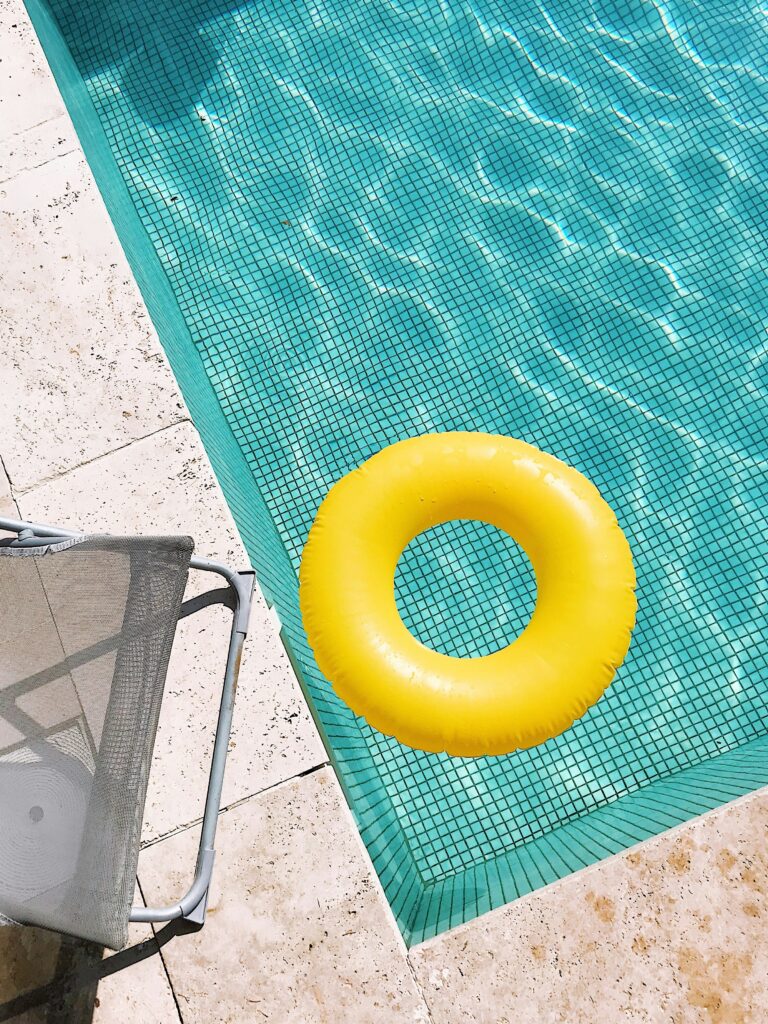Jumping in the pool is a great way to beat the summer heat. There are few things as fun as enjoying the nice weather with friends and family at the community pool or even your own backyard. While going to the pool is practically a must during the summertime, it’s important to take basic safety precautions and follow posted instructions to reduce the risk of an accident occurring. In this article, we discuss some safety tips you can use to make a family day at the pool fun and safe.

Planning for Your Pool Visit
Before heading to the pool, it’s a good idea to do a little research on the facility that you’ll be visiting. Look for a pool that offers trained lifeguards on duty during operational hours, especially if you have children or weak swimmers in your group. Lifeguards have the training, skills, and equipment to quickly react to most poolside emergencies. If a facility has lifeguards, make sure they are certified through a reputable program. An untrained lifeguard can make an emergency situation worse, in some cases even resulting in a lawsuit for personal injury.
You’ll want to pack some crucial items for the day. If you’re going to an outdoor pool, be sure to bring some sunscreen with UVA and UVB protection. Be sure to reapply sunscreen regularly, especially after getting out of the water and drying off. Drink plenty of water throughout the day to ensure you don’t get dehydrated or suffer from heatstroke. And, of course, don’t forget a towel!
Once you arrive at the pool, check for signs that describe applicable rules and regulations. Familiarize yourself with the facility’s rules before hopping in the water so you don’t put yourself or other patrons at risk of injury. Some facilities may not offer lifeguard coverage, in which case there is usually a sign warning swimmers that no lifeguard is on duty.
Safety at the Pool
Even if a facility has lifeguards, you need to keep an eye on children and weak swimmers at all times. Children and weak swimmers may not fully understand the dangers present in even a controlled pool environment. Do not leave a child unattended at the pool, even for a few moments. To help you keep track of everyone in your party, you can consider implementing a buddy system. A buddy system works when you pair adults or older children with younger children, ensuring the kids are monitored at all times.
Pools often have designated swimming areas with varying depths. Stay at a depth you are comfortable with and do not go into deep or restricted areas of the pool if you cannot swim well. Doing so prevents accidents, injuries, and lifeguard rescues.
Taking Care of Yourself at the Pool
Sun protection allows you to avoid uncomfortable burns and blisters, as well as the risk of serious heat-related illnesses like heatstroke. Apply sunscreen thoroughly to exposed skin at least fifteen minutes before getting into the pool. Reapply every 2 hours, or more frequently if you spend a lot of time in the water. A wide-brimmed hat, sunglasses, and rashguard can provide additional sun protection.
In addition to keeping yourself from getting burned, it’s important to stay hydrated. Even though you’ll be in the water, it’s still possible to get dehydrated. Drink plenty of water throughout the day, even if you don’t feel thirsty. Try to stay away from sugary drinks, which can cause additional dehydration.
Water Safety Measures to Be Aware Of
If you are not a confident swimmer,you may consider taking some swimming lessons to enhance your confidence in the water. Basic swimming skills can significantly enhance your safety and enjoyment of the neighborhood pool.
Before jumping into the water at an unfamiliar facility, be sure to read the posted rules carefully. Common rules include no running around the pool deck, no diving in shallow areas, and no roughhousing. By following these rules, you help keep the pool as safe and fun as possible for all patrons. Be sure to brush up on key emergency procedures as well. Stay on alert for shouts for help, lifeguard whistles, or other types of alarm. It’s also good to know where first-aid equipment and flotation devices are as well, particularly if a facility does not have lifeguards on duty.
What to Do After Your Swim
Take a shower and rinse off after swimming. Doing so will get excessive chlorine and pool chemicals off your skin, which can limit irritation to your skin and eyes. If you have young children, they may need help rinsing off to ensure all chemicals are thoroughly washed off.
Following your swim, monitor yourself and others for any signs of illness or injury. Many pool goers experience sunburns, especially if they didn’t put on enough sunscreen. A sunburn can manifest as redness, a painful sensation, or blistering. Cool water and moisturizing ointment can help your skin heal from a mild burn quickly. If you experience any concerning symptoms outside the norm, seek professional medical assistance as soon as possible..
We hope these safety tips help you and your loved ones enjoy your next trip to the pool!

